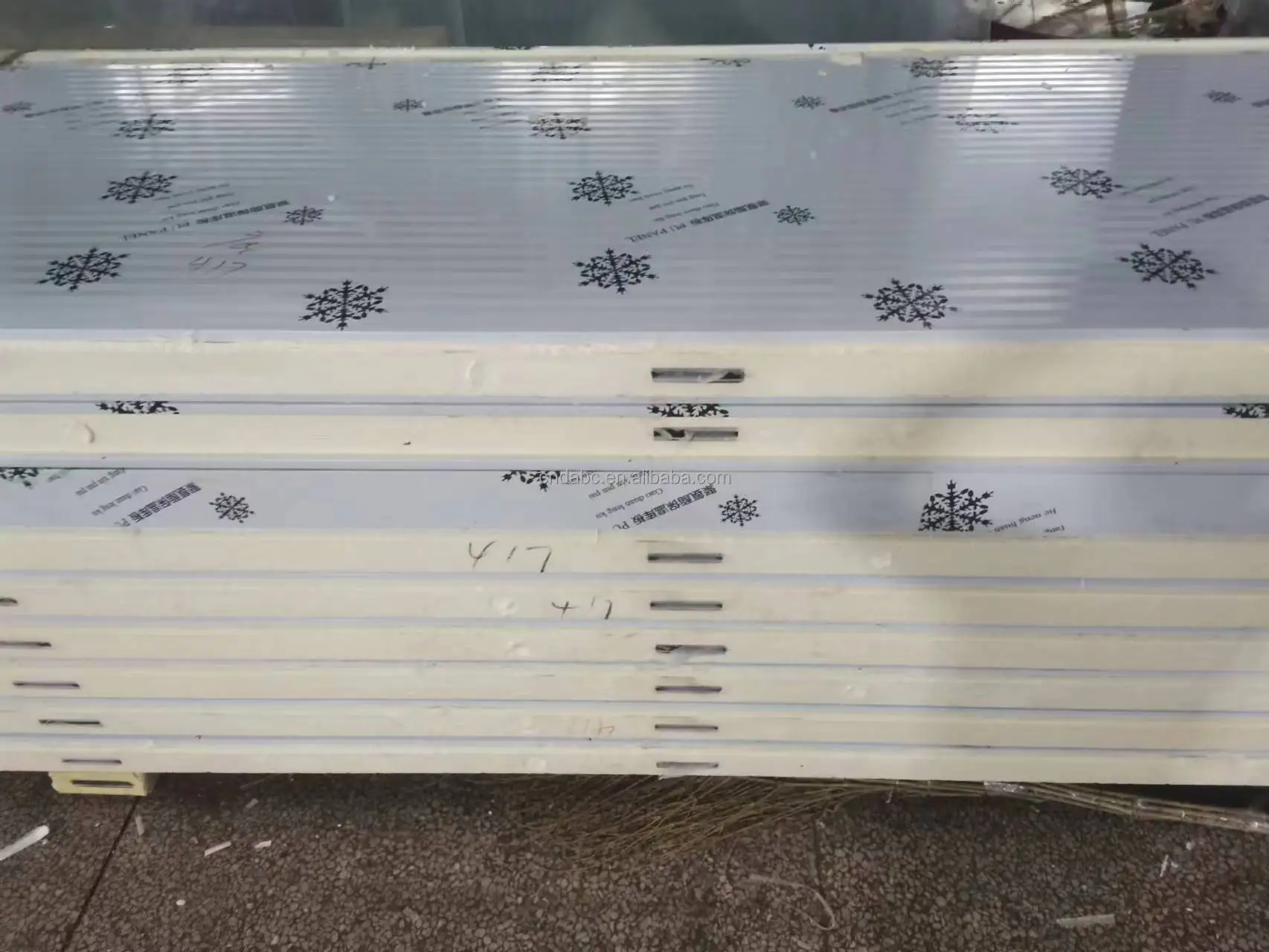Superior Thermal Insulation and Temperature Stability
Understanding R-value and U-value in cold room panel performance
The thermal efficiency of cold storage panels really comes down to two main factors: R-value, which measures how well something resists heat flow, and U-value that tells us about the rate at which heat moves through materials. These days, most commercial installations are going for panels rated above 4.0 R-value. The International Building Association reported this trend in their 2024 findings, noting that such high performing panels actually stop about 18% more heat movement compared to regular ones. Looking at insulation options, the latest data from the 2024 Insulation Materials Report shows polyurethane cores keep U-values under 0.22 W per square meter Kelvin. That makes them roughly 31% better than polystyrene alternatives when it comes to controlling temperature inside refrigeration spaces.
How high thermal resistance ensures consistent internal temperatures
High R-value panels reduce thermal bridging at joints by 65%, significantly minimizing temperature fluctuations. ASHRAE field data (2023) shows facilities using R�4.0 panels experience 19% fewer compressor cycles per hour compared to systems with R=3.0, enhancing temperature stability and system efficiency.
The role of vapor barriers in minimizing condensation and heat transfer
Integrated 0.5mm vapor barriers reduce moisture infiltration by 35–40% in -18°C environments. This prevents surface ice formation—a key advantage for pharmaceutical storage, where 72% of contamination risks stem from condensation (FDA Compliance Guidelines 2023).
Trend: Rising demand for panels with R-value >4.0 for enhanced efficiency
In 2024, 35% of cold storage operators upgraded to R>4.0 panels, driven by updated ASHRAE 90.1 energy standards. These panels reduce annual thermal leakage by 2.8 kWh/m² in typical 500m² facilities, translating to approximately $4,200 in yearly energy savings.
Energy Efficiency and Long-Term Cost Savings
Reducing energy consumption through high-performance cold room insulation
High-performance cold room panels reduce refrigeration energy demands by 18–22% compared to standard insulation, based on 2024 thermal efficiency studies. Polyurethane cores with R-values above 4.0 create an airtight thermal envelope, limiting heat transfer—especially critical in food storage, where refrigeration accounts for 65% of total energy use.
Lower compressor runtime and reduced operational electricity costs
Superior insulation reduces compressor workload, leading to 28% fewer cooling cycles daily. This optimization cuts annual electricity costs by $9–$14 per square foot in commercial facilities, as shown in energy management research. Reduced mechanical strain also extends refrigeration equipment lifespan by 3–5 years.
Calculating ROI: Financial benefits of investing in premium cold room panels
A 2024 cost analysis of 72 refrigeration facilities found that premium panel installations achieve full ROI within 26 months through energy savings alone. Over a 10-year period, the average facility saved $387,000 in operational costs while retaining 94% insulation effectiveness—outperforming basic panels by 41% in long-term value retention.
Industry data: Up to 30% lower energy use with advanced insulated panels
Facilities using R-5.0 panels consume 29.7% less energy than those meeting minimum building codes, according to industry benchmarks. Pharmaceutical warehouses adopting these solutions reduced peak energy demand by 31%, achieving annual savings of $740,000 (Ponemon 2023) without compromising temperature stability.
Durability, Structural Integrity, and Low Maintenance

Robust Construction for Long Service Life in Demanding Environments
The best cold room panels are made with materials that won't rust easily, typically using galvanized steel or sometimes stainless steel on the outside. According to some research from last year, when these panels are installed correctly with strong joints, they can last well beyond four decades even if temperatures drop below zero degrees Fahrenheit. The way these panels fit together without gaps helps stop cracks from forming under stress. Inside, there's usually a special type of plastic core treated against UV light damage, which makes them last longer in those damp places where food gets stored or medicines sit waiting. This matters a lot because many facilities need reliable insulation without constant repairs.
Modular Design and Structural Strength Reducing Repair Frequency
Cold room panels today can handle loads of around 40 psi which makes them great for heavy duty jobs where we need to stack things higher without worrying about extra support structures. The modular setup really helps cut down on repair costs too. Facilities that switched to replacing just damaged sections instead of whole panels saw their maintenance bills drop by nearly two thirds when compared with old school retrofit methods. What's particularly smart about these panels are the double tongue and groove connections plus those compression sealed edges. These features actually stop the kinds of failures that typically happen because of all that expansion and contraction from temperature changes in cold storage environments.
Metal-Faced vs. Composite Panels: Comparing Durability and Use Cases
Stainless steel panels dominate pharmaceutical applications due to their 99.8% microbial surface resistance, while composite polyethylene-core variants provide superior impact resistance for logistics hubs handling palletized goods. Recent testing reveals:
- Metal-faced panels: 25% higher dent resistance but require anti-condensation coatings in sub-zero operations
- Composite panels: 40% lighter with comparable insulation (R-5.2 vs. R-5.0)
- Hybrid designs: Aluminum-magnesium alloy skins with PIR foam cores show 31% lower 10-year maintenance costs than standard models
All types meet ANSI/ASHRAE 15-2022 safety standards when installed with manufacturer-recommended sealants.
Hygienic Design and Compliance with Industry Standards
Non-Porous, Easy-to-Clean Surfaces Preventing Microbial Contamination
High-quality cold room panels feature seamless, non-porous surfaces that prevent bacterial and mold growth in crevices. These hygienic designs withstand rigorous cleaning with steam, pressure washing, or industrial sanitizers without degradation. In food and pharmaceutical settings, this reduces contamination risks by over 90% compared to textured surfaces (Food Safety Magazine 2023).
Meeting FDA, GMP, and ISO Standards for Food and Pharmaceutical Storage
Regulatory requirements shape cold room panel specifications, with materials conforming to FDA Title 21 CFR Part 117, Good Manufacturing Practices (GMP), and ISO 14644 cleanroom standards. Leading healthcare construction guidelines highlight welded seams and antimicrobial coatings as essential for maintaining hygiene in sensitive applications like raw meat or injectable medication storage.
Case Study: Certified Panels Ensuring Compliance in Vaccine Cold Storage
A 2023 deployment of ISO 9001-certified panels in a vaccine distribution hub resulted in zero temperature deviations or sanitation failures during FDA audits. The facility maintained 99.97% particulate-free air using panels with integrated gaskets and rounded corners—critical for sterility in biologics storage.
Moisture Control and Prevention of Thermal Bridging
Effective Moisture Management Using Integrated Vapor Barriers
High-quality cold room panels incorporate multi-layer vapor barriers that block 98% of moisture ingress, according to a 2021 Building Science study. These laminated polymer layers prevent internal condensation and maintain airtight seals at joints—essential for pharmaceutical storage, where humidity must remain within ±5% RH.
How Proper Installation Minimizes Thermal Bridging and Cold Leaks
In cold rooms where installation isn't quite right, thermal bridging can lead to anywhere from 15 to 30 percent energy losses. There are several good approaches though. When panels are positioned so their seams don't line up straight across, when we switch out conductive hardware for better alternatives, and when PU foam gets applied properly at joints, these methods together cut down on heat transfer by about 40% according to what professionals have seen working on site. What this actually does is create what's called a continuous thermal barrier around the room. This keeps those outside walls warm enough above the dew point temperature, which stops condensation from forming and eventually turning into frost buildup over time.
Best Practices: Sealing Techniques for Optimal Cold Room Panel Performance
| Technique | Purpose | Performance Impact |
|---|---|---|
| Butyl tape joints | Blocks air/moisture infiltration | Reduces energy use by 12–18% |
| Closed-cell foam gaskets | Compensates for thermal expansion | Prevents 90% of seam ice buildup |
| Corner bracket insulation | Eliminates metal-to-metal contact | Lowers bridging heat transfer by 63% |
These methods align with ASHRAE Guideline 32-2023, which requires linear thermal transmittance to remain below 0.25 W/m²K for certified cold storage walls.
FAQ
What is R-value and why is it important for cold room panels?
R-value measures the thermal resistance of an insulation material. Higher R-values indicate better insulation, meaning less heat transfer, which is essential for maintaining consistent internal temperatures in cold room panels.
How do high-performance panels benefit energy consumption?
High-performance panels reduce energy consumption by creating an effective thermal barrier, minimizing the workload on cooling equipment and cutting electricity costs significantly.
What materials are used in high-quality cold room panels?
High-quality cold room panels are often made from materials like galvanized steel or stainless steel with polyurethane cores. These materials provide excellent insulation and durability.
Why are vapor barriers integrated into cold room panels?
Vapor barriers are integrated to prevent moisture ingress, which can lead to condensation and ice formation. This is crucial for maintaining hygiene and temperature stability in sensitive storage environments.
How does proper installation impact the efficiency of cold room panels?
Proper installation minimizes thermal bridging and energy losses by ensuring a continuous thermal barrier and effective sealing techniques, which prevents unwanted heat transfer and condensation.
Table of Contents
- Superior Thermal Insulation and Temperature Stability
- Energy Efficiency and Long-Term Cost Savings
- Durability, Structural Integrity, and Low Maintenance
- Hygienic Design and Compliance with Industry Standards
- Moisture Control and Prevention of Thermal Bridging
-
FAQ
- What is R-value and why is it important for cold room panels?
- How do high-performance panels benefit energy consumption?
- What materials are used in high-quality cold room panels?
- Why are vapor barriers integrated into cold room panels?
- How does proper installation impact the efficiency of cold room panels?

